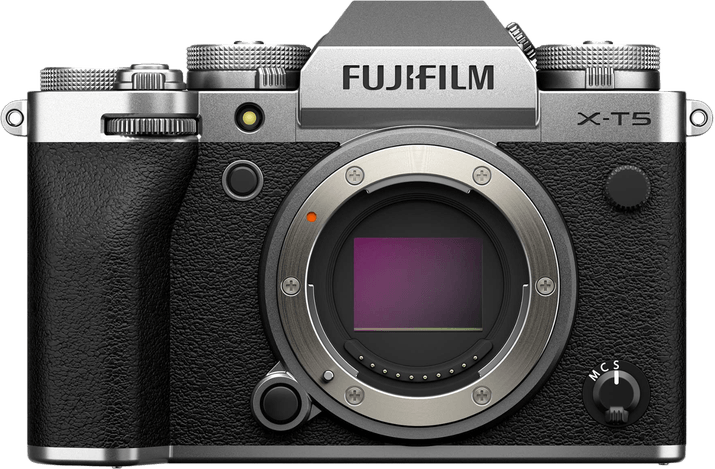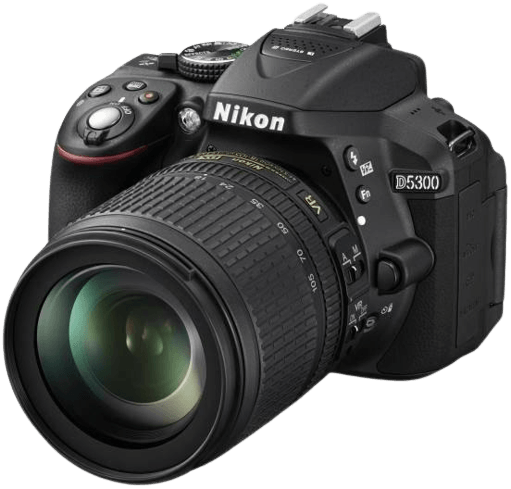Fujifilm X-T5 vs Nikon D5300 Comparison
Fujifilm X-T5

Nikon D5300

The Fujifilm X-T5 outperforms the Nikon D5300 with a score of 81/100 compared to 57/100. Both cameras share similarities, including their announcement and release years (2022 for the X-T5 and 2013 for the D5300) and launch prices ($1699 for the X-T5 and $800 for the D5300).
The X-T5 excels as a mirrorless camera with a compact size of 130 x 91 x 64mm and a weight of 557g. Its higher score reflects its superior performance and features compared to the D5300.
On the other hand, the Nikon D5300 has a lighter weight of 480g and a slightly smaller size of 125 x 98 x 76mm, making it more portable as a DSLR camera. However, its lower score indicates that it may not provide the same quality and performance as the Fujifilm X-T5.
Considering the differences in scores and specifications, it’s clear that the Fujifilm X-T5 is the better choice for those seeking a high-performing, compact mirrorless camera, while the Nikon D5300 is a more affordable and portable option for DSLR enthusiasts.
Fujifilm X-T5 vs Nikon D5300 Overview and Optics
The Fujifilm X-T5 outperforms the Nikon D5300 in optics with a score of 81/100, a difference of 16 points compared to the Nikon’s 65/100. Both cameras share some common specifications, such as having a CMOS sensor, an APS-C sensor size, and a similar lens mount (Fujifilm X for the X-T5 and Nikon F DX for the D5300).
The Fujifilm X-T5 excels in several areas. With 40 megapixels, it captures more detail than the Nikon D5300’s 24.2 megapixels. Its shooting speed of 15 is significantly faster than the Nikon’s 5, allowing for quicker action shots. The X-T5 also benefits from a more advanced processor, the X-Processor 5, providing better image processing and performance. Additionally, the Fujifilm X-T5 has image stabilisation, a feature absent in the Nikon D5300, resulting in sharper images and better low-light performance.
On the other hand, the Nikon D5300 has a DXOMARK score of 83 for its sensor, while the Fujifilm X-T5 does not have a DXOMARK score, as the company does not evaluate Fujifilm cameras. This score suggests that the Nikon D5300 may have a better sensor performance in certain conditions.
Taking these points into consideration, the Fujifilm X-T5 clearly has an advantage in optics with its higher megapixel count, faster shooting speed, advanced processor, and image stabilisation. The Nikon D5300, although having a good DXOMARK score, falls short in comparison. The Fujifilm X-T5 is the superior choice for those prioritising optics and image quality.
Fujifilm X-T5 vs Nikon D5300 Video Performance
The Fujifilm X-T5 outperforms the Nikon D5300 in video capabilities with a score of 87/100 compared to the D5300’s 70/100. Both cameras share some common specifications, such as a maximum video frame rate of 60fps and built-in time-lapse functionality. However, the X-T5 boasts superior video quality and resolution, making it the better choice for videographers.
The Fujifilm X-T5 excels with its 6K maximum video resolution and dimensions of 6240×4160, offering crisp and detailed footage. This high resolution allows for greater flexibility in post-production, such as cropping and zooming without losing quality. The X-T5’s impressive video capabilities make it an ideal choice for professional videographers and content creators who demand top-notch video quality.
On the other hand, the Nikon D5300’s maximum video resolution is Full HD with dimensions of 1920×1080. While this resolution is sufficient for casual users and amateur videographers, it falls short of the X-T5’s capabilities. However, the D5300 still delivers decent video quality and shares the same maximum frame rate and time-lapse functionality as the X-T5, making it a suitable option for those who prioritize other features and budget over video resolution.
Comparing these two cameras, the Fujifilm X-T5 clearly surpasses the Nikon D5300 in terms of video capabilities due to its higher resolution and dimensions. For those seeking exceptional video quality, the X-T5 is the superior choice. However, the Nikon D5300 remains a viable option for casual users and those with budget constraints, as it still offers satisfactory video performance and shares some features with the X-T5.
Fujifilm X-T5 vs Nikon D5300 Features and Benefits
The Fujifilm X-T5 outperforms the Nikon D5300 with a feature score of 85/100, compared to Nikon’s 46/100. Both cameras share some specifications, including a 3-inch screen size, flip screen, and WIFI connectivity. However, the X-T5 excels in other areas, making it the superior camera in terms of features.
The Fujifilm X-T5 boasts a higher screen resolution of 1,840,000 dots, whereas the Nikon D5300 has a screen resolution of 1,037,000 dots. This difference in resolution provides the X-T5 with a clearer and more detailed display. Additionally, the X-T5 has a touchscreen, making navigation and control more intuitive. The X-T5 also includes Bluetooth connectivity, allowing for seamless communication between devices, a feature that the Nikon D5300 lacks.
On the other hand, the Nikon D5300 has a slightly larger screen size of 3.2 inches, offering a marginally bigger display. The D5300 also features GPS, which the Fujifilm X-T5 does not have. This GPS functionality enables photographers to geotag their images, providing location information for better organization and documentation.
In terms of features, the Fujifilm X-T5 clearly surpasses the Nikon D5300. With a higher screen resolution, touchscreen capability, and Bluetooth connectivity, the X-T5 outshines its competitor. Although the Nikon D5300 has a larger screen size and GPS functionality, these advantages do not compensate for the overall superiority of the Fujifilm X-T5. Thus, the X-T5 is the better choice for those prioritizing camera features.
Fujifilm X-T5 vs Nikon D5300 Storage and Battery
The Fujifilm X-T5 outperforms the Nikon D5300 in storage and battery, scoring 76/100 compared to the D5300’s 29/100. Both cameras accept SD, SDHC, and SDXC memory cards. However, the X-T5 has two memory card slots, while the D5300 has only one, providing the X-T5 with greater storage flexibility.
In terms of battery life, the Nikon D5300 has a slight advantage, offering 600 shots per charge with its EN-EL14a battery, compared to the Fujifilm X-T5’s 580 shots using the NP-W235 battery. Despite this, the X-T5 has the added benefit of USB charging, which the D5300 lacks.
Considering these factors, the Fujifilm X-T5 is the superior choice for storage and battery capabilities, with an additional memory card slot and USB charging functionality. The Nikon D5300’s slightly longer battery life does not compensate for its shortcomings in other areas.
Fujifilm X-T5 vs Nikon D5300 – Our Verdict
Are you still undecided about which camera is right for you? Have a look at these popular comparisons that feature the Fujifilm X-T5 or the Nikon D5300:

